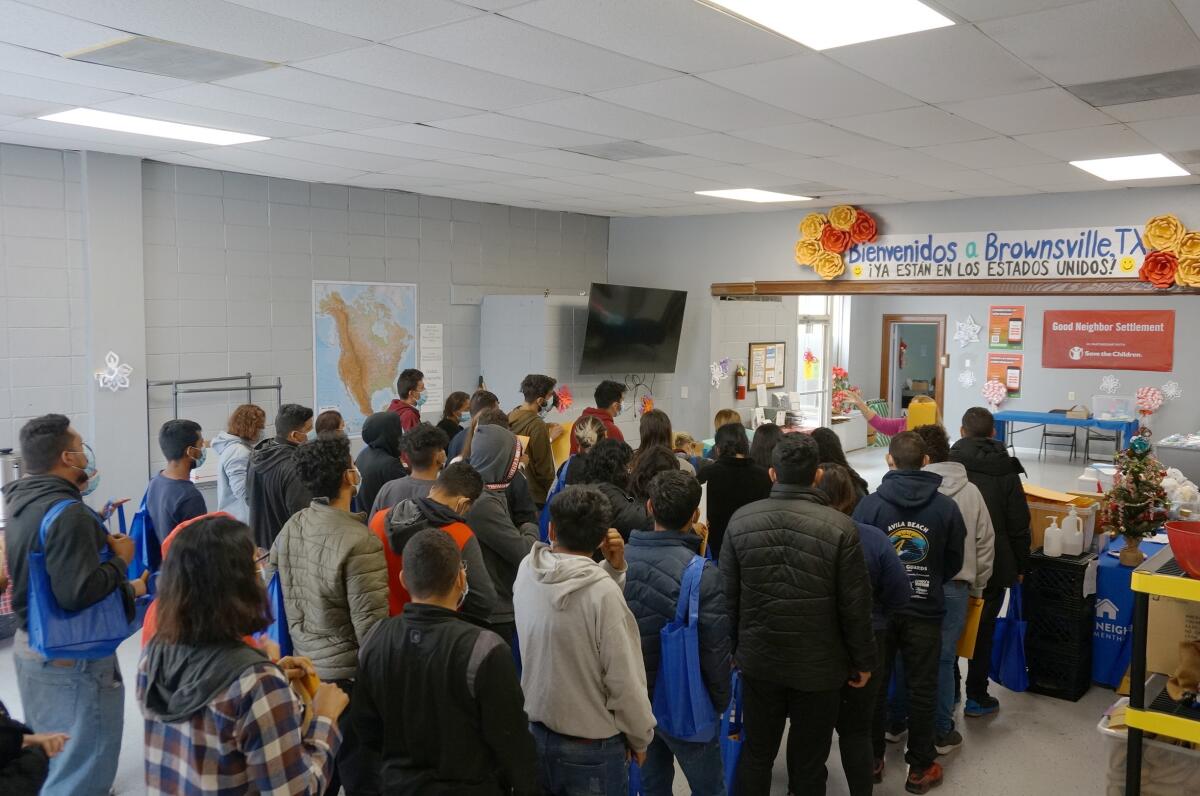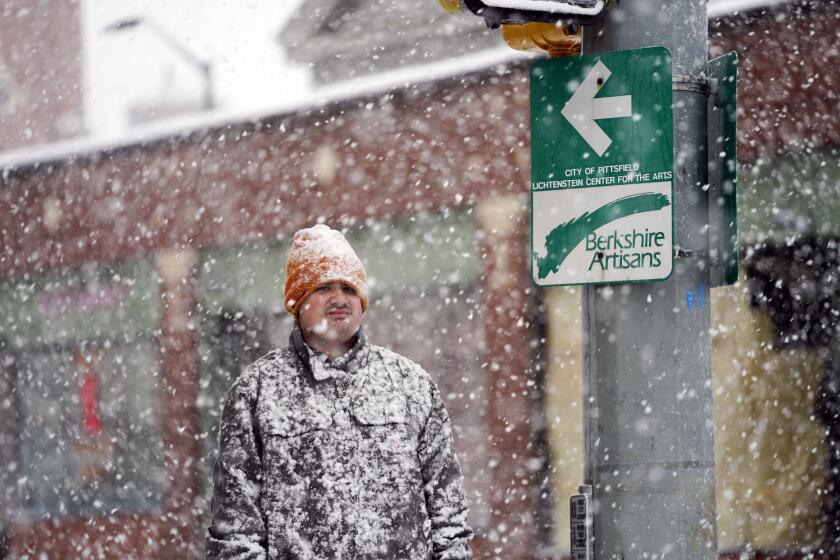Texas and Mexico cities strained before expected migrant surge

- Share via
EL PASO — Along the U.S. southern border, two cities — El Paso and Mexico’s Ciudad Juárez — prepared Sunday for a surge of as many as 5,000 new migrants a day as pandemic-era immigration restrictions expire this week, setting in motion plans for emergency housing, food and other essentials.
On the Mexican side of the border, only heaps of discarded clothes, shoes and backpacks remained Sunday morning on the banks of the Rio Grande, where until a couple of days ago hundreds of people were lining up to turn themselves in to U.S. officials.
A young man from Ecuador stood uncertain on the Mexican side; he asked two journalists if they knew anything about what would happen if he turned himself in without having a sponsor in the U.S., and then gingerly removed sneakers and socks and hopped across the low water.
On the American side, by a small fence guarded by several Border Patrol vehicles, he joined a line of a dozen people who stood waiting with no U.S. officials in sight.
El Paso County Judge Ricardo Samaniego told the Associated Press on Sunday that the region, home to one of the busiest border crossings in the country, was coordinating housing and relocation efforts with groups and other cities, as well as calling on the state and federal government for humanitarian help. The area is preparing for an onslaught of new arrivals that could double their daily numbers once public health rule Title 42 ends Wednesday.
The rule has been used to deter more than 2.5 million migrants from crossing since March 2020.
Temperatures in the region were set to drop below freezing this week, and on Sunday people wrapped in Red Cross blankets were walking near the airport.
Forecasters are warning of treacherous holiday travel and life-threatening cold for big parts of the nation, an arctic air mass blows into the already-frigid southern United States
At a migrant shelter not far from the river in a poor Ciudad Juárez neighborhood, Carmen Aros, 31, knew little about U.S. policies. She heard the border might close Wednesday.
She fled the cartel violence in the Mexican state of Zacatecas a month ago, right after her fifth daughter was born and her husband went missing. The Methodist pastor who runs the Buen Samaritano shelter put her on a list to be paroled into the United States, and she waits every week to be called.
“They told me there was asylum in Juarez, but in truth, I didn’t know much,” she said on the bunk bed she shared with the girls. “We got here … and now let’s see if the government of the United States can resolve our case.”
At a vast shelter run by the Mexican government in a former Ciudad Juárez factory, dozens of migrants watched the World Cup final Sunday on two TVs while a visiting team of doctors from El Paso treated many who had come down with respiratory illness in the cold weather.
Dylan Corbett, who leads the group that started the clinic two months ago, said constantly changing policies make it hard to plan, and desperation grows.
“You have a lot of pent-up pain,” he said. “I’m afraid of what’s going to happen.” With government policies in disarray, “the majority of the world falls to faith communities to pick up the pieces and deal with the consequences.”
Just a couple blocks across the border, sleet fell in El Paso as about 80 huddled migrants ate tacos that volunteers grilled up. Temperatures in the region were set to drop below freezing this week.
“We’re going to keep giving them as much as we have,” said Veronica Castorena, who came out with her husband with tortillas and ground beef as well as blankets for those who will likely sleep on the streets.
Jeff Petion, the owner of a trucking school in town, said this was his second time coming with employees to help migrants in the streets.
“They’re out here, they’re cold, they’re hungry, so we wanted to let them know they’re not alone,” he said.
But across the street from Petion, Kathy Countiss, a retiree, said she worries the new arrivals will get out of control in El Paso, draining resources and directing enforcement away from criminals to those claiming asylum.
On Saturday, El Paso Mayor Oscar Leeser issued a state of emergency declaration allowing the Texas border city access to additional local and state resources for building shelters and other urgently needed aid.
Samaniego said the order came one day after El Paso officials sent Gov. Greg Abbott a letter requesting humanitarian assistance for the region, adding that the request was for resources to help tend to and relocate the newly arriving migrants, not additional security forces.
Samaniego said he has received no response to the request and plans to issue a similar county-wide emergency declaration specifying the kind of help the area needs if the city does not get state aid soon.
The city of El Paso announced Wednesday that it received a new $6-million commitment from the Federal Emergency Management Agency, but Samaniego said the area is still short millions of dollars it needs to house and provide food and aid to the new arrivals. He urged the state and federal governments to provide the additional money.
Samaniego said city and county officials have been working closely with NGOs to provide temporary housing for migrants while they are processed and given sponsors, as well help in relocating them to bigger cities where they can be flown or bused to their final destinations.
City and county officials will join forces with NGOs at a one-stop emergency command center beginning Wednesday, Samaniego said. Similar command centers have been established previously for COVID-19 response and following the deadly 2019 Walmart shooting in El Paso.
Abbott and El Paso city officials did not immediately respond to requests for comment on Sunday.
Abbott has committed billions of dollars to “Operation Lone Star,” an unprecedented border security effort that has included busing migrants to so-called sanctuary cities including New York, Los Angeles and Washington, as well as a massive presence of state troopers and National Guard along the Texas-Mexico border.
Additionally, the Republican governor has pushed continued efforts to build former President Trump’s wall using mostly private land along the Texas-Mexico border and crowdsourcing funds to help pay for it.
El Paso was the fifth-busiest of the Border Patrol’s nine sectors along the Mexico border as recently as March and suddenly became the most popular by far in October, jumping ahead of Del Rio, Texas, which itself had replaced Texas’ Rio Grande Valley as the busiest corridor at lightning speed late last year.
The recent surge in El Paso — at first largely by Venezuelans and more recently among Nicaraguans — was reminiscent of a short period in 2019, when the westernmost reaches of Texas and eastern end of New Mexico were quickly overwhelmed with new arrivals from Cuba and Central America. El Paso had been a relatively sleepy area for illegal crossings for years.
It is unclear why El Paso became such a magnet, especially in September. Nicolas Palazzo, an attorney at Las Americas Immigrant Advocacy Center in El Paso, suspects that smugglers calculated it was a good place to run operations, echoing a widely held view. The Border Patrol, with limited capacity to move agents temporarily, has trouble keeping up.
More to Read
Sign up for Essential California
The most important California stories and recommendations in your inbox every morning.
You may occasionally receive promotional content from the Los Angeles Times.











